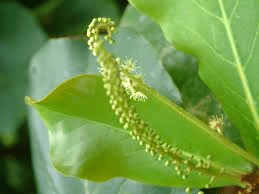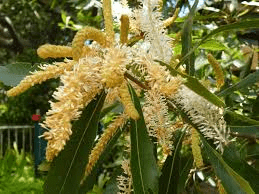Almond inflorescence refers to the flowers of the almond tree, which are produced in clusters on the branches of the tree. The almond tree is a deciduous tree that grows up to 10 meters tall and is native to the Middle East. The flowers of the almond tree are white or pale pink in color and have a five-petaled corolla. Almond inflorescence is a complex structure that consists of the peduncle, the rachis, the pedicels, and the flowers themselves.
The almond inflorescence plays a crucial role in the reproduction of the almond tree. The flowers of the almond tree are hermaphroditic, which means that they have both male and female reproductive organs.
The male reproductive organs produce pollen, which is transferred to the female reproductive organs by pollinators such as bees. Once the pollen has been transferred, the female reproductive organs produce the almond fruit, which is the edible part of the almond tree.
The almond inflorescence is also important from an economic perspective. Almonds are a valuable agricultural crop that is grown around the world.
The almond tree is a relatively hardy crop that can grow in a range of climates and soil types. The almond fruit is used in a variety of food products, including almond milk, almond butter, and almond flour. Almonds are also used in cosmetic products, such as soaps and lotions, and in pharmaceutical products, such as cough syrup.
In addition to its economic importance, the almond inflorescence is also a beautiful and ornamental feature of the almond tree. The white or pink flowers of the almond tree are a popular sight in gardens and parks around the world. The almond tree is also a popular choice for bonsai enthusiasts due to its delicate and intricate flowers.
The almond inflorescence is a complex and important structure that plays a crucial role in the reproduction of the almond tree and has significant economic and ornamental value.
The Economic Importance and Uses of Almond Inflorescence

1. Pollination: Almond inflorescence plays a crucial role in pollination. Bees are primarily responsible for pollinating almond trees, transferring pollen from one flower to another, which is essential for fruit development.
2. Almond Production: The inflorescence of almond trees ultimately leads to almond production. Each pollinated flower develops into a fruit containing a seed, which is the almond itself.
3. Food Source: Almond inflorescence provides a vital food source for bees and other pollinators. This relationship is symbiotic, as bees aid in the pollination process necessary for almond production.
4. Almond Oil: Almond oil is extracted from almond seeds, which develop from the fertilized flowers of almond inflorescence. This oil is used in various industries, including cosmetics, food, and pharmaceuticals.
5. Culinary Uses: Almond inflorescence contributes to the culinary world through almond nuts, which are used in a variety of dishes, both sweet and savory, adding flavor, texture, and nutrients.
6. Nutritional Value: Almonds derived from almond inflorescence are highly nutritious, containing essential nutrients such as vitamins, minerals, protein, and healthy fats. They are consumed as a healthy snack and incorporated into many recipes.
7. Beverage Production: Almond milk is a popular dairy alternative made from almonds and water. It is produced by grinding almonds with water and then straining the mixture to remove solids. Almond inflorescence indirectly contributes to the production of almond milk.
8. Aesthetic Purposes: Almond inflorescence adds aesthetic value to landscapes and gardens with its beautiful flowers. The blossoms create a visually appealing sight during the flowering season, enhancing the environment.
9. Medicinal Uses: Almond oil extracted from almond seeds is used in traditional medicine for various purposes, including skin care, hair care, and massage therapy. It is believed to have moisturizing, nourishing, and soothing properties.
10. Soil Improvement: Almond trees contribute to soil improvement by promoting soil health and fertility. Their root systems help prevent erosion and improve soil structure, making them beneficial for sustainable agriculture.
11. Erosion Control: The extensive root systems of almond trees help stabilize soil and prevent erosion, particularly on slopes and hillsides. This erosion control function is essential for maintaining soil integrity and preventing environmental degradation.
12. Livelihoods: Almond production provides livelihoods for farmers, farmworkers, and other individuals involved in the almond industry. It supports rural economies and communities by creating jobs and generating income.
13. Environmental Benefits: Almond trees contribute to environmental conservation by sequestering carbon dioxide and mitigating climate change. They act as carbon sinks, absorbing atmospheric carbon and storing it in their biomass and the soil.
14. Renewable Resource: Almond inflorescence represents a renewable resource, as almond trees can be cultivated and harvested annually without depleting natural resources excessively.
15. Cultural Significance: Almonds have cultural significance in various societies and traditions around the world. They are often associated with celebrations, rituals, and symbolic meanings, reflecting their importance in human history and culture.
16. Wildlife Habitat: Almond orchards provide habitat and forage for wildlife species, including birds, insects, and small mammals. They contribute to biodiversity conservation and support ecosystem functioning.
17. Economic Value: Almond production and related industries contribute significantly to the economy, generating revenue, exports, and business opportunities. Almond inflorescence plays a central role in this economic value chain.
18. Research and Development: Almond inflorescence serves as a subject of research and development in various fields, including agriculture, botany, genetics, and horticulture. Studies on almond trees and their flowers contribute to scientific knowledge and innovation.
Read Also: 15 Medicinal Health Benefits Of Aleppo Pepper (Capsicum annuum var. annuum)
The Products and By-products That Can Be Derived From Almond Inflorescence

1. Almond Nuts: The primary product derived from almond inflorescence is the almond nut itself. These nuts are harvested from the mature fruit of almond trees and are consumed raw, roasted, or processed into various food products.
2. Almond Oil: Almond oil is extracted from almond seeds, which develop from the fertilized flowers of almond inflorescence. The oil is used in cosmetics, skincare products, culinary applications, and pharmaceuticals.
3. Almond Milk: Almond milk is a dairy alternative made from almonds and water. It is produced by grinding almonds with water and then straining the mixture to remove solids. Almond milk is used as a beverage and as an ingredient in cooking and baking.
4. Almond Flour: Almond flour is made by grinding blanched almonds into a fine powder. It is used as a gluten-free alternative to wheat flour in baking and cooking, adding flavor, moisture, and nutrients to recipes.
5. Almond Butter: Almond butter is made by grinding almonds into a creamy spreadable consistency. It is a nutritious alternative to peanut butter and is used as a spread, topping, or ingredient in recipes.
6. Almond Extract: Almond extract is a concentrated flavoring made from bitter almonds or almond oil. It is used to impart almond flavor to various culinary creations, including baked goods, desserts, and beverages.
7. Almond Meal: Almond meal is similar to almond flour but has a coarser texture as it includes the almond skins. It is used in baking and cooking to add texture, moisture, and nutty flavor to recipes.
8. Almond Paste: Almond paste is made from ground almonds, sugar, and sometimes egg whites. It is used as a filling or ingredient in pastries, confections, and desserts, adding sweetness and almond flavor.
9. Almond Syrup: Almond syrup is a sweet syrup flavored with almond extract or almond essence. It is used as a flavoring agent in beverages, cocktails, and desserts, adding a hint of almond flavor.
10. Marzipan: Marzipan is a sweet confection made from almond paste and sugar. It is often molded into various shapes and decorations for cakes, pastries, and candies.
11. Almond Liqueur: Almond liqueur is a flavored liqueur made with almonds or almond extract. It is used as a dessert spirit or cocktail ingredient, adding a rich almond flavor to drinks.
12. Almond Vinegar: Almond vinegar is a type of fruit vinegar made from almonds or almond-infused wine. It is used in cooking, salad dressings, and marinades, adding a subtle nutty flavor to dishes.
13. Almond Shell: The hard outer shell of almond nuts can be used as a biomass fuel or as a component in various industrial processes, such as abrasive blasting or filtration media.
14. Almond Hulls: The outer hulls of almond fruits can be composted or used as animal feed, providing nutrients and fiber to soil or livestock.
15. Almond Wood: Almond wood is used in woodworking and carpentry for furniture, flooring, and decorative items. It is valued for its hardness, durability, and attractive grain patterns.
16. Almond Husks: Almond husks, the fibrous outer covering of almond seeds, can be used as mulch or bedding material in gardening and agriculture, improving soil moisture retention and weed suppression.
17. Almond Shell Flour: Ground almond shells can be used as an abrasive material in polishing, cleaning, and exfoliating products, such as cosmetics, toothpaste, and skincare formulations.
Read Also: 18 Medicinal Health Benefits Of Ground Elder (Aegopodium podagraria)
Frequently Asked Questions (FAQs) About Almond Inflorescence

1. What is almond inflorescence?
Almond inflorescence refers to the flowers of almond trees, which bloom in clusters on the branches before giving way to almond fruits.
2. When do almond trees bloom?
Almond trees typically bloom in late winter or early spring, depending on the climate and geographical location. The exact timing of blooming varies from region to region.
3. How long do almond blossoms last?
Almond blossoms typically last for about two weeks, during which the trees are adorned with beautiful white or pink flowers.
4. Do almond trees self-pollinate?
Most almond varieties are not self-pollinating and require cross-pollination between different cultivars for optimal fruit set and yield.
5. What pollinates almond trees?
Bees are the primary pollinators of almond trees. Commercial beekeepers often transport beehives to almond orchards during the bloom period to facilitate pollination.
6. How are almonds harvested?
Almonds are harvested by shaking the trees to dislodge the ripe fruits, which fall to the ground where they are collected and processed.
7. What are the health benefits of almonds?
Almonds are rich in nutrients, including vitamin E, magnesium, and healthy fats. They are associated with various health benefits, such as improved heart health, weight management, and blood sugar control.
8. Can almond inflorescence be used for medicinal purposes?
Almond oil extracted from almond seeds is used in traditional medicine for its purported skincare, haircare, and therapeutic properties.
9. Are almond trees sustainable?
Almond trees are considered relatively sustainable compared to some other crops due to their ability to thrive in arid climates and their potential for carbon sequestration.
10. What environmental impacts are associated with almond production?
Almond production requires significant water resources, leading to concerns about water usage in drought-prone regions. Additionally, intensive agriculture practices may impact soil health and biodiversity in almond-growing areas.

